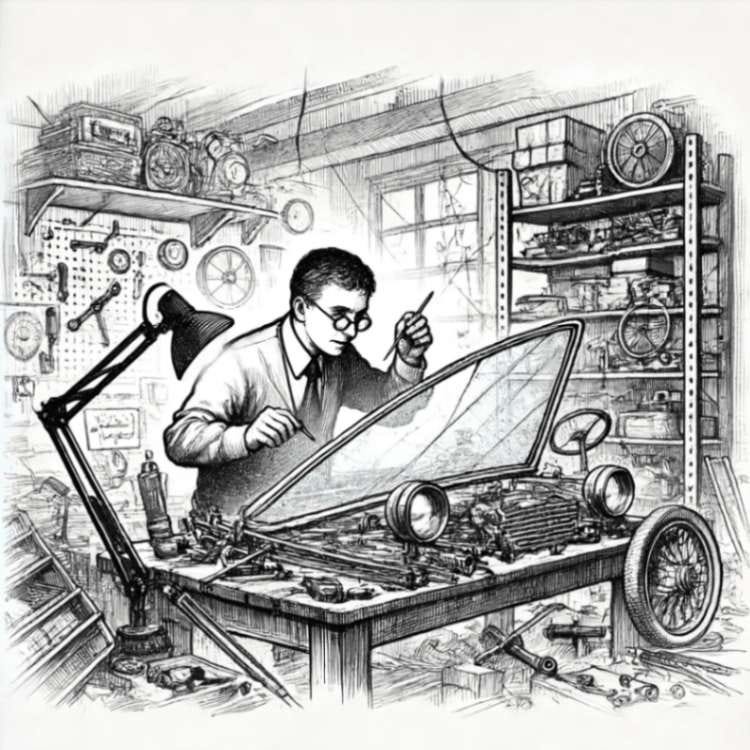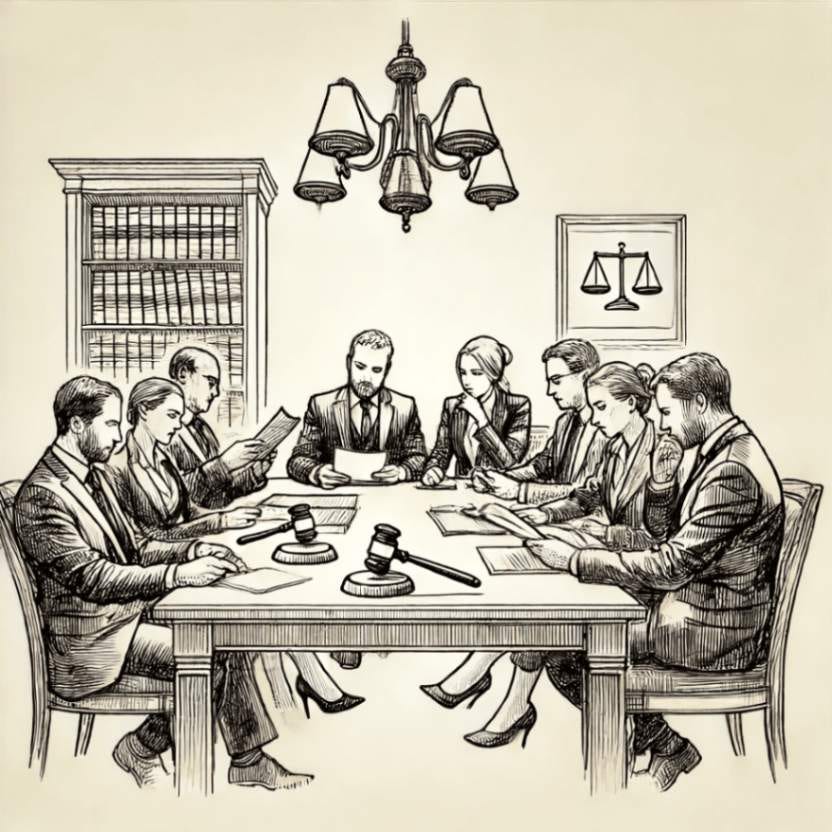In 1990, Bob Kearns’ case finally went to trial.
But he was not there.
Bob was in a jungle, cooking over a fire.
He had originally filed the case 12 years ago.
It was him – an inventor – fighting against a giant corporation, Ford.
Back in 1962, he was driving through rain.
His windshield wiper was set to ‘slow’.
Back then, wipers came in two modes: slow and fast.
This was problematic.
When it rained heavily, drivers could keep it on ‘fast’. No problem.
When it was raining lightly, drivers kept it on ‘slow’. But this made the wiper move across the windshield slowly.
The slow-moving wiper would block the view of the driver. It might even lead to an accident.
Bob wondered if the wipers could move like how we blink.
He wanted the wipers to always move fast – but wait a bit before restarting again.
Normal wiper modes:
Fast: swipe left and right quickly. Repeat.
Slow: swipe left and right slowly. Repeat.
What Bob wanted:
Fast: swipe left and right quickly. Repeat. (Same as before).
Slow: swipe left and right quickly. Wait – wait – wait. Repeat.
So, when driving in slow rain, the wiper would not obstruct the view of the driver.
In the 1960s, this was a problem all carmakers were trying to solve. But none of them were able to come up with a good solution.
Bob got to work.
In his basement, he spent hours coming up with a design.
Then, he made an actual model.
It worked.
He approached Ford. They agreed to meet him.
They were immediately excited. It was a problem they wanted to solve too.
They signed an agreement with him and asked him to test the wipers. He tested it for 6 months and came back with successful results.
Bob had also applied for a patent for his invention. He called it ‘intermittent wipers’.
Since this was a safety-related part, Ford wanted to see how it actually worked. Bob showed it to Ford engineers.
A few months later, Ford told Bob that they were canceling the agreement.
To Bob’s horror, Ford then launched a car with intermittent wipers – using the same technology.
They had stolen his design!
Bob was shocked.
He hired law firms to file a case against Ford. He was unhappy with their plans and strategy. He changed law firms many times.
In the end, he decided to fight his case without a lawyer. Bob fought his own case.
This matter consumed his time.
Meanwhile, other carmakers also copied the same wiper design.
He was not able to give his wife and children enough time. He would spend hours reading about law and similar cases – preparing for his own case.
He eventually filed a case against Ford in 1978.
After 12 years of fighting his case, the case reached its conclusion in 1990.
By this point, the dispute wrecked Bob’s life.
He suffered from mental health problems, barely spent any time with his children when they were growing up, and ended up divorcing his wife.
The court found Ford guilty. They were ordered to pay Bob $10 million.
Bob Kearns had won.
This is one of the most famous intellectual property cases in history.
He then went on to file a case against another car maker – Chrysler.
He won that case too. He was awarded around $20 million.
Bob’s case is seen as a successful example of an inventor winning against a large corporation.
There are many articles on this topic. There is even a movie made on him: Flash of Genius.
Biggest disputes
Elias Howe invented the modern-day sewing machine. He had a similar dispute with big machine makers.
Thomas Edison was in dispute with Westinghouse over the use of AC (alternating current). He lost the case.
The corporate world is filled with disputes over intellectual property.
Intellectual property disputes are common.
Apple vs Samsung: Apple sued Samsung in 2011.
What was the dispute?
Design. Apple accused Samsung of copying the iPhone’s design.
A few years later, they settled the dispute outside court.
Similarly, Kodak and Polaroid had a long-standing dispute over instant photography.
Kodak eventually lost.
Intellectual property
This brings us to the question: what is intellectual property?
Intellectual property is not one thing. It is a category of things.
It offers protection for creations.
It includes:
-Engineering inventions and designs (patents)
-Logos, slogans, tag lines, etc (trademarks)
-Art, music, literature, software code, etc (copyright)
Even trade secrets, manufacturing methods, drugs, proteins, plant types, etc are covered under it.
The idea is quite simple.
If someone puts in a significant amount of time and effort, they should be rewarded for it – if their creation ends up making money.
Let’s say you worked for five years and invented a device. Then, you launched it.
What happens if everyone else copies it and sells the same device?
Soon, nobody will invent anything. Everybody will just wait for someone else to invent things – so that they may copy from them.
This is why intellectual property rights exist.
If you make something incredible, you have a right to profit from it.
Licensing model
You can license others to use your intellectual property.
Chester Carlson invented the photocopying machine.
He licensed it to a company called Haloid.
Haloid manufactured photocopiers and made them a successful product. In the process, Chester got licensing fees and grew rich.
Later, the company’s name changed from Haloid to Xerox.
The Chester-Xerox story is a fantastic example of a good inventor-manufacturer collaboration.
These days, it is more common for companies to invent and create in their research and development labs.
Individual inventors are rare.
There are companies that specialize in creating only.
They create, and then they license out their creations.
Arm
Arm is a microchip designing company.
It is based in the UK and designs microchips. These chips are the brains of computers, smartphones, and hundreds of other devices.
It is quite peculiar how most people do not know about Arm but depend on it so much.
You might have heard of Snapdragon – the maker of chips that are used in the best smartphones today. Their chips are based on Arm’s chip design.
Even Apple’s iPhone, iPad, and Macbooks use Arm-based chips.
Arm designs chips.
They do not manufacture chips. They do not market and distribute chips. They do not sell chips.
All they do is give licenses to others (Apple, Samsung, Qualcomm, etc).
Then, those companies do everything else.
Their entire business model depends on their intellectual property.
There are many companies like Arm.
Gilead develops drugs and pharmaceuticals. They may license manufacturing to other companies – even marketing and distribution.
Disney owns many characters (cartoons, etc.), media, music, shows, movies, etc.
It licenses these copyrights to others in return for commissions (example: merchandise makers).
This business model is adopted by many big companies – even if it is not their main business model.
Sony and Samsung are two big companies in the electronics industry that are famous for giving out licenses to other electronics companies.
Similarly, software companies like Adobe, Microsoft, Oracle, etc. license their software to other companies.
Car companies like Toyota license their technology to other car companies.
It’s more common than we realize.
Intangible assets
So the next time you see ‘intangible assets’ on the balance sheets of a company, know that it could include all sorts of intellectual property.
Intellectual property is a big part of a company’s success.
Some companies make it their entire business model.
The images above were generated using AI tools.
Quick Takes
+India’s exports rose 9.1% year-on-year to $38.13 billion in May. Imports also rose 7.7% to $61.90 billion in May. Trade deficit stood at $23.78 billion.
+India’s wholesale price inflation was 2.61% year-on-year in May (vs 1.26% in April).
+Forex reserves rose by $4.3 billion to an all-time high of $655.8 billion as of 7 June: RBI data.
+Retail inflation in India fell to a 12-month low of 4.75% in May (vs 4.83% in April). Food inflation fell to 8.62% in May (vs 8.75% in April).
+India’s Index of Industrial Production (IIP) stood at 5% year-on-year in April (vs 4.6% in 2023). Production of mining and power sectors rose the most.
+Ixigo IPO was subscribed 98.10 times. Retail subscription stood at 53.95 times.
+Domestic passenger vehicle sales rose 4% year-on-year in May. Also, 2-wheeler sales rose around 10% and 3-wheeler sales rose around 15% in May: SIAM.
6-Day-Course
Theme of the week: index
We’ve reached the end of this week’s course that started on Monday. Here’s a test you should take. Get pen and paper!
Question 1:
In the last 20 years, the Indian markets have given a return of around _______ % per annum.
-10
-14
-20
Question 2:
We cannot compare the returns of Nifty 50 and S&P 500 without converting the investment into the same currency (either USD or INR).
-True
-False
Question 3:
Returns from gold are always fixed. It is just like a fixed deposit.
-True
-False
Question 4:
Like FDs in India, the US has a similar investment option called as
_______________________?
-US fixed deposit
-Certificate of deposit
-Permanent deposit
Question 5:
Returns from all real estate options like land, flats, etc. are similar and comparable.
-True
-False
Answers:
Q1: 14
Q2: True
Q3: False
Q4: Certificate of deposit
Q5: False
The information contained in this Groww Digest is purely for knowledge. This Groww Digest does not contain any recommendations or advice.
Team Groww Digest







